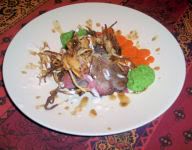I'm going to try cooking my second brisket - the first one didn't turn out at all, but a number of things went wrong in the process (heavy rain, wind, sand in the waterpan instead of water, etc). This time I want to do it right so I'm not gonna experiment or wing it too much. I have a few questions though.
1) The meat is supposed to be 165F when it's done. I want to have it ready around dinner time, so somewhere around 4-6pm give or take. Some places on the net say to calculate 1.5 - 2 hours per pound at 220F, while Paul Kirk says 45 mins to an hour per pound at 230-250F. "Barbecue'n on the Net" says that any brisket cooked for 8-10 hours at 225F is done. For a 10lb brisket, that creates a huge window and I'd like it to be a little more predictable. How long should I expect it to cook for if the temp is about 230F? I guess I'm basically asking if I should make it an overnighter or a 6am type of thing.
2) Some say not to trim off any fat, some say leave 1/8" or so. I would think that since the bullet is a water smoker, the steam would keep the meat moist and less fat is needed to "self-baste" it. I also think it's a bit of a waste to put rub on fat that will either get trimmed off in the end or melt and take the rub with it... But I could be wrong. What do you recommend?
3) I'm in south western Ontario, Canada, and I've never been anywhere that serves brisket or met anyone that cooks it. What do I serve it with? Slices on a bun with saus and coleslaw on top? Just plain old slices with a sauce and potatoes? Slices with baked beans and slaw on the side?
Thanks for any replies,
-- Calle
1) The meat is supposed to be 165F when it's done. I want to have it ready around dinner time, so somewhere around 4-6pm give or take. Some places on the net say to calculate 1.5 - 2 hours per pound at 220F, while Paul Kirk says 45 mins to an hour per pound at 230-250F. "Barbecue'n on the Net" says that any brisket cooked for 8-10 hours at 225F is done. For a 10lb brisket, that creates a huge window and I'd like it to be a little more predictable. How long should I expect it to cook for if the temp is about 230F? I guess I'm basically asking if I should make it an overnighter or a 6am type of thing.
2) Some say not to trim off any fat, some say leave 1/8" or so. I would think that since the bullet is a water smoker, the steam would keep the meat moist and less fat is needed to "self-baste" it. I also think it's a bit of a waste to put rub on fat that will either get trimmed off in the end or melt and take the rub with it... But I could be wrong. What do you recommend?
3) I'm in south western Ontario, Canada, and I've never been anywhere that serves brisket or met anyone that cooks it. What do I serve it with? Slices on a bun with saus and coleslaw on top? Just plain old slices with a sauce and potatoes? Slices with baked beans and slaw on the side?
Thanks for any replies,
-- Calle


